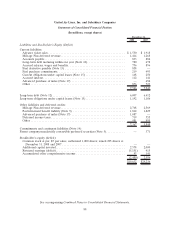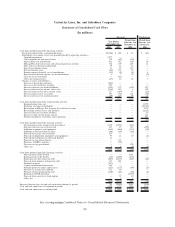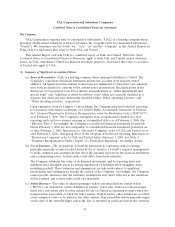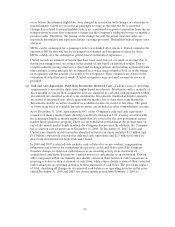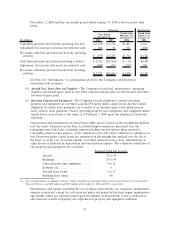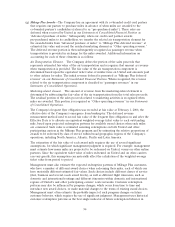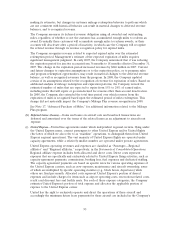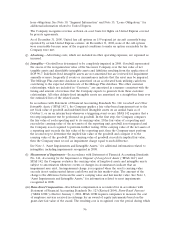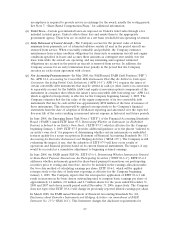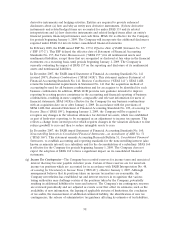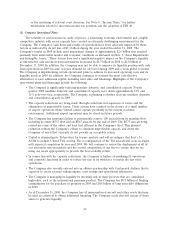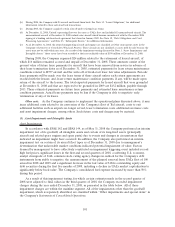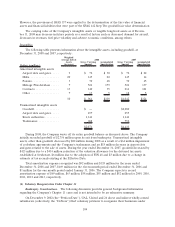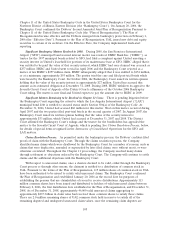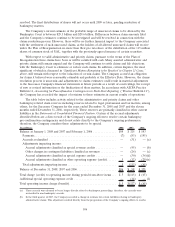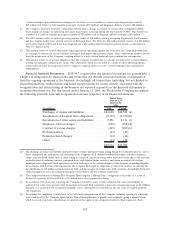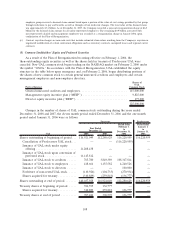United Airlines 2008 Annual Report Download - page 98
Download and view the complete annual report
Please find page 98 of the 2008 United Airlines annual report below. You can navigate through the pages in the report by either clicking on the pages listed below, or by using the keyword search tool below to find specific information within the annual report.derivative instruments and hedging activities. Entities are required to provide enhanced
disclosures about (a) how and why an entity uses derivative instruments, (b) how derivative
instruments and related hedged items are accounted for under SFAS 133 and its related
interpretations and (c) how derivative instruments and related hedged items affect an entity’s
financial position, financial performance and cash flows. SFAS 161 is effective for the Company
for periods beginning January 1, 2009. The Company will incorporate the additional disclosures
required under SFAS 161 into its future consolidated financial statements.
In February 2008, the FASB issued FSP No. 157-2, Effective Date of FASB Statement No. 157
(“FSP 157-2”). This FSP delayed the effective date of Statement of Financial Accounting
Standards No. 157, Fair Value Measurements (“SFAS 157”) for all nonfinancial assets and
nonfinancial liabilities, except those that are recognized or disclosed at fair value in the financial
statements on a recurring basis, until periods beginning January 1, 2009. The Company is
currently evaluating the impact of SFAS 157 on the reporting and disclosure of its nonfinancial
assets and nonfinancial liabilities.
In December 2007, the FASB issued Statement of Financial Accounting Standards No. 141
(revised 2007), Business Combinations (“SFAS 141R”). This statement replaces Statement of
Financial Accounting Standards No. 141, Business Combinations (“SFAS 141”). SFAS 141R
retains the fundamental requirements in Statement No. 141 that the acquisition method of
accounting be used for all business combinations and for an acquirer to be identified for each
business combination. In addition, SFAS 141R provides new guidance intended to improve
reporting by creating greater consistency in the accounting and financial reporting of business
combinations, resulting in more complete, comparable and relevant information for users of
financial statements. SFAS 141R is effective for the Company for any business combinations
with an acquisition date on or after January 1, 2009. In accordance with the provisions of
SFAS 141R that amended Statement of Financial Accounting Standards No. 109, Accounting for
Income Taxes (“SFAS 109”), beginning January 1, 2009, the Company will be required to
recognize any changes in the valuation allowance for deferred tax assets, which was established
as part of fresh-start reporting, to be recognized as an adjustment to income tax expense. This
reflects a change from current practice which requires changes in the valuation allowance to first
reduce goodwill to zero and then to reduce intangible assets to zero.
In December 2007, the FASB issued Statement of Financial Accounting Standards No. 160,
Noncontrolling Interests in Consolidated Financial Statements—an amendment of ARB No. 51
(“SFAS 160”). This statement amends Accounting Research Bulletin 51, Consolidated Financial
Statements, to establish accounting and reporting standards for the noncontrolling interest (also
known as minority interest) in a subsidiary and for the deconsolidation of a subsidiary. SFAS 160
is effective for the Company for periods beginning January 1, 2009. The Company does not
expect the adoption of SFAS 160 to have a significant impact on its consolidated financial
statements.
(q) Income Tax Contingencies—The Company has recorded reserves for income taxes and associated
interest that may become payable in future years. Certain of these reserves are for uncertain
income tax positions which are accounted for in accordance with FASB Interpretation No. 48,
Accounting for Uncertainty in Income Taxes (“FIN 48”), effective January 1, 2007. Although
management believes that its positions taken on income tax matters are reasonable, the
Company nevertheless has established tax and interest reserves in recognition that various
taxing authorities may challenge certain of the positions taken by the Company, potentially
resulting in additional liabilities for taxes and interest. The Company’s tax contingency reserves
are reviewed periodically and are adjusted as events occur that affect its estimates, such as the
availability of new information, the lapsing of applicable statutes of limitations, the conclusion
of tax audits, the measurement of additional estimated liability, the identification of new tax
contingencies, the release of administrative tax guidance affecting its estimates of tax liabilities,
98


